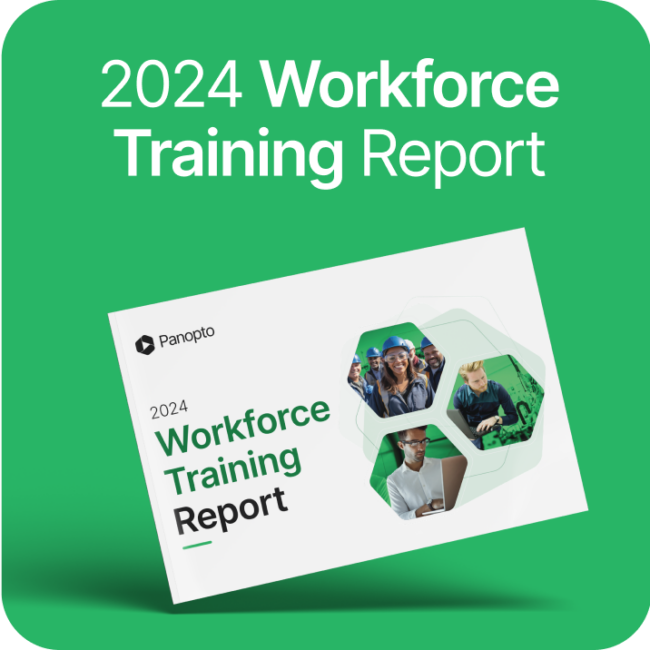- Academic Technology
Beyond lecture capture: The expanding use of video for traditional and online learning
Only a short time ago, video was a novelty in the classroom. An instructor may have opted to present an occasional recording with the help of a TV wheeled in from the AV department, but at best, the technology was an infrequent part of students’ daily learning experiences.
Today, video has become so common in the classroom that Gartner has entirely removed the technology from both its Hype Cycle and Market Clock reports for Higher Education. In doing so, the firm has made clear that, thanks to wide-scale adoption, video is now just as expected in the classroom as projectors and whiteboards.
How did we get here?
For starters, it’s the results. In an independent survey by Wainhouse Research, a majority of respondents reported that implementing lecture capture yielded a variety of benefits. Students found that on-demand videos helped them study more effectively and provided a more personalized learning experience. Faculty gained new opportunities to more effectively use existing materials and available class time. Respondents even reported that recorded lectures helped improve grades, and made their schools more competitive.
That enthusiasm has led to widespread adoption. According to the same study, lecture capture has already been adopted either campus-wide or at the departmental level in 80% of universities.
As instructors have come to embrace video, students have come to expect it. When available, data collected from numerous institutions indicates that 3 in 4 students on average will watch lecture recordings. Of those who do, more than 95% will report the videos were a valuable part of their learning experience and 80% will factor the availability of lecture capture into their future course selections.
The Rise Of Video In The Classroom
Beyond traditional lecture capture, the uses for video in higher education continues to expand. Just a few of today’s applications for the technology include:
- Creating a “campus YouTube”, enabling departments and libraries to curate in-house and licensed video for classroom learning and research.
- Flipping the classroom, where instructors record and share details from an upcoming lecture in advance, thereby freeing up class time for discussion and interactive learning.
- Student assignments, where students record themselves either in class or at home, with the resulting video used by teachers, peers, and the student themselves to review and critique a presentation or role-play performance.
- Streaming campus events, allowing institutions to share commencement, guest lectures, and other high profile occasions with parents, families, alumni, and their communities live via the web.
- Staff and faculty training, enabling instructors and staff to view training on-demand, to better fit into the varied work schedules common to academia.
- Internal and external communications, shared either securely or publicly, delivering news, announcements, and more to those on and around campus.
- Recruiting and alumni relations, promoting the institution, its fundraising initiatives, and all the great work being done on campus.
- Athletics and coaching, including capturing practices for player review and improvement, as well as streaming matches not available elsewhere for alumni and fans to follow along.
Just like lecture capture, these once-novel applications for video are quickly becoming common on campus.
Most notable among these is the flipped classroom. Only eight years after its introduction, the NMC Horizon Report named the flipped classroom one of the most important developments in educational technology. Already in place in 30% of classrooms and anticipated in another 27% this year, the Horizon report recommends institutions plan for a “one year or less” adoption horizon for the requisite flipped classroom tools, including video.
And classroom flipping is hardly an outlier. Analysis of the more than 2 million videos stored in the Panopto Video Cloud finds:
- 38% of academic videos recorded in 2016 — more than 1 in every 3 videos — are less than 15 minutes long, offering further evidence of the popularity of non-lecture recordings like flipped classrooms and student presentations.
- 41% of academic videos created in 2016 now include 2 or more simultaneous video streams (multiple views of a lab experiment or field exhibit, for example, or video of the instructor teaching synced alongside video from their laptop screen as they work out a problem). This trend suggests faculty have become comfortable with video, and are now increasingly leveraging video to capture and share more complex demonstrations and activities.
- And 76% of schools have experimented with live streaming classrooms and events at least once, and many have now made live online broadcasts a regular activity.
Video has become an expected part of today’s higher education learning experience, and schools should consider the full breadth of use cases for the technology as they make their investments.
Institutions that fail to plan appropriately run the risk of providing substandard support for video, thereby undermining their student learning experiences and putting the institution at a competitive disadvantage. Those schools may also find themselves pressed to support a disparate set of point solutions sourced at the departmental level, creating a support burden on campus technology teams and delivering a disjointed experience for faculty and students.
In either situation, the institution will likely need to conduct a second video platform RFP in order to find another solution that will more fully meet their needs.
How Well Does Your LMS Support Video?
In the last two years, the markets for LMS and video technologies in higher education have both undergone significant change. Are you keeping up with what’s current?
Read Gartner’s latest analysis of the higher education LMS market, then take a closer look at the unique challenges of supporting video within the LMS, including:
- The latest data on video use in the classroom
- 15 capabilities an institution needs to support video within the LMS
- Comparing the video features of Blackboard, Canvas, Brightspace, and Moodle along with those of dedicated video platforms
It’s all in Gartner Research’s latest newsletter. Click to download your free copy of the report now.




